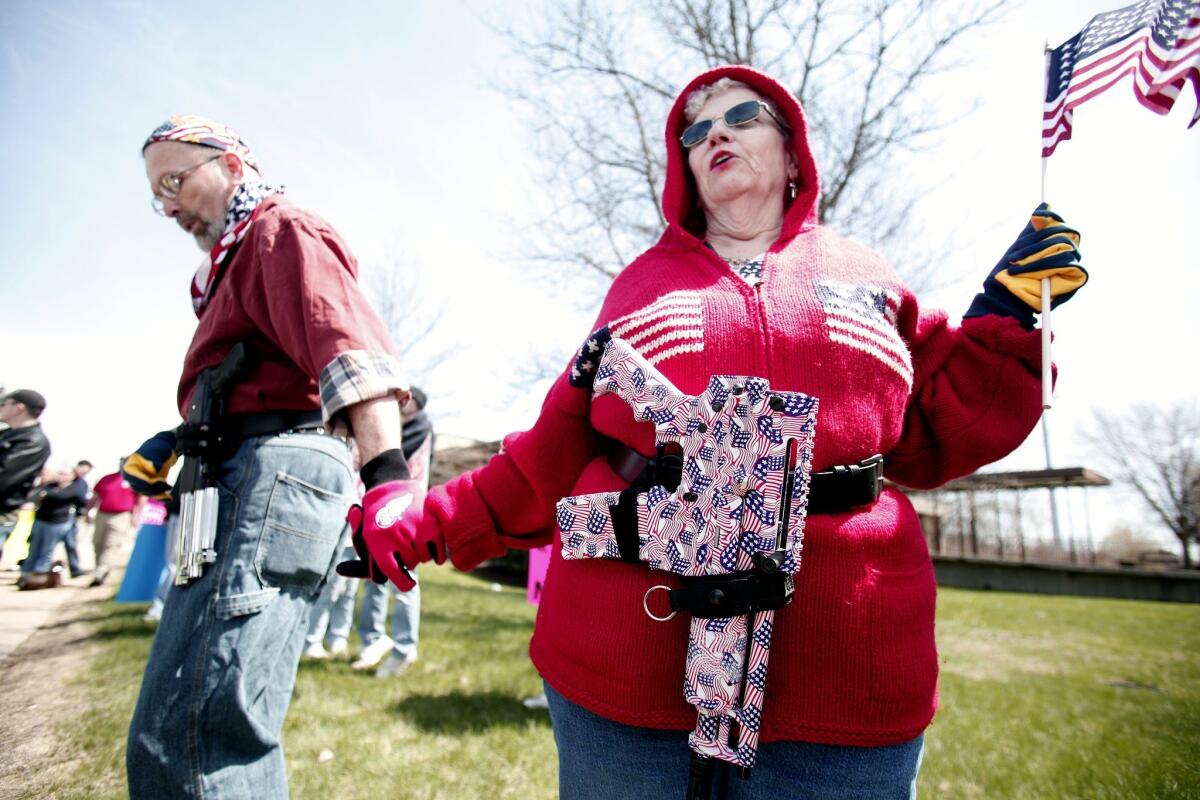Opinion: The Supreme Court punts on chance to end gun-control confusion

- Share via
The Supreme Court’s ruling about public displays of religion Monday provoked a lot of discussion, obscuring an equally intriguing decision the court issued that day about public displays of guns.
In Town of Greece vs. Galloway, the court lifted a prohibition it had placed in 1983 on sectarian prayers at government events, such as city council meetings. The Times’ editorial board, being composed of godless heathens (it’s in the job description), complained that the justices had betrayed the constitutional principle that the government and its institutions belong to all Americans regardless of faith.
(I was kidding about the godless heathens part -- it’s not in the job description.)
That’s a big deal, and it will be interesting to see how local officials across the country try to push the boundaries of permissible prayer.
The gun case, Drake vs. Jerejian, presented another big constitutional question: Does the 2nd Amendment guarantee Americans the right to carry handguns outside the home for self-defense? But the court decided not to hear the case, despite conflicting rulings in the appellate courts about states’ abilities to restrict gun permits.
At issue was a New Jersey law that makes it extremely difficult for anyone to obtain the permit necessary to carry a handgun outside one’s home. Applicants have to show that they have a “justifiable need,” which the law defines as “the urgent necessity for self-protection, as evidenced by specific threats or previous attacks which demonstrate a special danger to the applicant’s life that cannot be avoided by means other than by issuance of a permit to carry a handgun.”
The plaintiffs in the lawsuit included two individuals who’d been denied permits. One, John Drake, repairs and restocks ATMs, according to his attorneys. The other, Finley Fenton, is a reserve sheriff’s deputy concerned about reprisals from the people he’s arrested. A federal judge rejected their claim, as did the U.S. 3rd Circuit Court of Appeals, saying the state’s “justifiable need” standard didn’t violate the 2nd Amendment. Drake and company urged the Supreme Court to overturn the lower courts and clarify that the right to keep and bear arms applies outside the home as well as inside.
Well, that’s a bit of an oversimplification. The justices ruled six years ago, in District of Columbia vs. Heller, that the 2nd Amendment gave Americans the right to keep guns to ward off attackers, especially in their homes. It’s not an unrestricted right, the majority wrote, but it can’t be abridged blithely. Several federal appeals panels -- including the 9th Circuit, whose turf includes California -- have held that Heller’s reasoning extends to guns carried in public, and they’ve tossed out restrictive state permitting requirements. Even the 3rd Circuit acknowledged that 2nd Amendment rights extend beyond one’s curb, but it held that “longstanding” state restrictions on gun-toting are permissible.
The question left unresolved is how far states can go to regulate the possession of handguns in public, whether they be carried openly or concealed. Is there a presumption in favor of a gun owner’s right to be armed at the supermarket or in the park? Or is the right limited to owners who have a reason to fear an attack? And if so, how far should someone have to go to prove it? In other words, is it enough to show that your concern is reasonable, or do you have to have actual evidence of being endangered (e.g., written death threats, hospital records from a previous attack or footage of someone stalking you)?
Drake vs. Jerejian could have settled that question, and the court should have taken the case. After all, Justice Antonin Scalia’s opinion in Heller teed up the issue. And Drake seemed to be an ideal plaintiff: Someone who carries around bricks of cash for ATM machines would seem to be a pretty good candidate for a permit to carry a gun. The fact that even Drake couldn’t get a permit in New Jersey shows just how restrictive the state’s approach is to handguns; by the plaintiffs’ estimate, less than 2 out of every 10,000 residents have obtained permits to carry guns outside their homes.
The state’s policy may not be wrong, but it’s hard to reconcile with a 2nd Amendment “right” to carry in public. The Supreme Court should have explained why New Jersey’s law is or isn’t constitutional. Instead, the law survives, gun control advocates have a rare court victory to tout, and the 2nd Amendment’s boundaries remain jagged and ill-defined.
More to Read
A cure for the common opinion
Get thought-provoking perspectives with our weekly newsletter.
You may occasionally receive promotional content from the Los Angeles Times.







